#twentieth century-studios
Explore tagged Tumblr posts
Text



The 1981 20th Century Fox logo had quite a number of variations, but did you ever notice the different searchlights animations in this logo?
Tweet version here
#20th century fox#twentieth century fox#twentieth century-fox#20th century studios#twentieth century studios#twentieth century-studios#twentieth century fox film corporation#logos#logo#opening logos#disney 100#walt disney studios motion pictures#walt disney studios#searchlights#2d animation#opening logo#1981#a salute to fox#throwback thursday#throwback thursdays#tbt
4 notes
·
View notes
Text

THIS is what made me scream in the theater! When he came onto screen, I literally screamed I was so excited to see BLADE since Trinity in 2004!
Everyone was "Chris Evans this, Johnny Storm that" I say mediocre cameo compared to THE character responsible for making Marvel, X-Men and the MCU a household name.
All the other cameos were great, at least the actors they got to come back. I was rather surprised at some of the actors that weren't brought back. Lady Deathstrike, Toad, Juggernaut, and a few others I can't remember off hand. Just wonder why they couldn't be squeezed in?
I am down for Wesley Snipes in any capacity in the MCU or in some form between now and Secret Wars.
#imdonnalynn#deadpool & wolverine#deadpool and wolverine#deadpool 3#wesley snipes#blade#mcu blade#new line cinema blade#eric brooks#blade 1998#marvel comics#marvel#mcu#marvel mcu#marvel studios#marvel films#twentieth century fox#twentieth century#new line cinema#avengers doomsday#avengers secret wars
17 notes
·
View notes
Text
bootleg 20th logos from my dvd collection :)

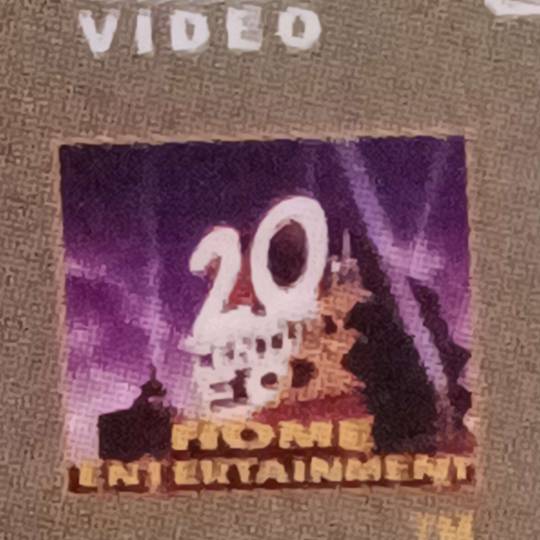

24 notes
·
View notes
Text
Surprise poll! I won’t check this very often, but I’m trying to decide what tournament to run next. So I am putting out a list of other animation companies next to 1-3 recognizable franchises or movies. The next polls should run sometime during 2024, so keep an eye out :).
REMEMBER: I will only be holding a tournament for movies, not tv shows.
(Also feel free to add in the tags or notes whether I should still keep running the Dreamworks Tournament separate from the Illumination Tournament in the coming years)
*This movie was both made by Dreamworks and Aardman, so if you feel like you voted for this movie before on this blog, you may have!
#I might go from most voted to least voted idk#these choices are mostly what I watched as a child#so it doesn’t include a ton of non-western options#illumination#twentieth century fox#sony pictures animation#studio ghibli#laika#aardman animations#cartoon network#warner bros animation#nickelodeon#rankin bass#rankin-bass#crest animation#Barbie
7 notes
·
View notes
Text

"I know you're all asking yourselves the same question. Why so blue?"
3 notes
·
View notes
Text




1968
youtube
youtube
youtube
youtube
youtube
youtube
https://www.nytimes.com/2023/03/31/movies/blood-sweat-tears-1970-tour.html?smid=url-share
#youtube#link#modern#20th century#jazz#modern music#modern jazz#modernism#twentieth century#20th century music#1960s#1960s music#60s music#60s#1968#vinyl#blood sweat and tears#david clayton thomas#david clayton-thomas#album#vinyl record#record#rock n roll#soul#soul music#video#smiling phases#more and more#and when i die#studio recording
1 note
·
View note
Text
"The First Omen" trailer. Can't tell what this has to do with any of the other "Omen" films. I liked the 1976 original. The remake was deadly dull. "Omen 3" was not bad.
1 note
·
View note
Text


Edith Head designed this incredible pink fur cloak for the Twentieth Century Fox (now Twentieth Century Studios) film 𝑾𝒉𝒂𝒕 𝒂 𝑾𝒂𝒚 𝒕𝒐 𝑮𝒐! Although Head was primarily associated with Paramount Studios, the star of 𝑾𝒉𝒂𝒕 𝒂 𝑾𝒂𝒚 𝒕𝒐 𝑮𝒐!, Shirley MacLaine, was important enough to be able to request Head be borrowed to work on the film. Her request was granted, and Head created this memorable costume for MacLaine’s character, Louisa May Foster. The budget for the film was one of the biggest that Head had ever been given, exceeding half a million dollars. “In case anyone has forgotten, that was a damn fortune in the early 1960s,” she says in 𝑬𝒅𝒊𝒕𝒉 𝑯��𝒂𝒅’𝒔 𝑯𝒐𝒍𝒍𝒚𝒘𝒐𝒐𝒅. This solves the mystery of why a Paramount designer worked on a Fox studio production, but what about the mystery of how this incredible piece wound up being worn by Ann-Margret for promotional photos for the 1965 MGM film 𝑶𝒏𝒄𝒆 𝒂 𝑻𝒉𝒆𝒊𝒇? It’s possible that after 𝑾𝒉𝒂𝒕 𝒂 𝑾𝒂𝒚 𝒕𝒐 𝑮𝒐! ended, that this costume made its way to a rental shop, such as Western Costume. Visit our site to see more photos of this incredible piece: bit.ly/Access208
#EdithHead#WhatAWayToGo#ShirleyMacLaine#OnceATheif#AnnMargret#VintageHollywood#GoldenAgeOfCinema#IconicCostume#Costumes#RecycledMovieCostumes
386 notes
·
View notes
Text
Peaceful Property went ahead and picked one of my special interests to explore this week. For queer history nerds like me, some of the most prominent questions in the field are whether and how to connect to those in the past who did not have the same conditions and language for queerness as we do in the present.* Forcebook gave us two characters, Phoom and Vicha, who failed to name or live their queer feelings in the past. Instead, they had queer gestures to offer across time. What do these queer gestures and failures offer to the main conflict between Peach and Home, and what do they offer to us as an audience debating whether Peaceful Property is a BL or queer-baiting?
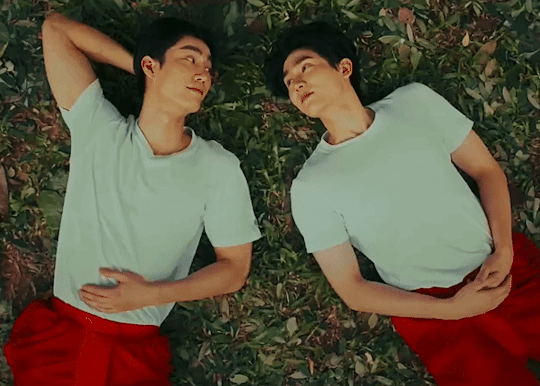
That ghost story spanned and blurred time into a time immemorial. Using the venue of Thai traditional dancing gave the story a sense of deep Thai history and traditions that are kept up to the present, while Phoom's home indicated early twentieth century Western influences, and a television (alongside Phoom's age in the modern-day setting) suggested the beginning of the global information age of the 80s or 90s. Then Force and Book, finally getting the opportunity to show their true acting capacities (let Force be as queer, emotive, and silly as he is in his interviews, GMMTV!!!), took us on a heart-shattering journey that blended those eras together.

In front of the TV, Vicha teaches Phoom the gesture for love before they kiss. It's not a pronouncement, and no one's recording. It's just a movement between two men tucked away in a private place. Vicha records later, but he doesn't put it into words. He carves tallies into a tree waiting for Phoom to return. Then Phoom does, but he's so cold toward Vicha that the latter can't even bear to look as Phoom tries to explain his sadness through dance. Phoom's mother is looking on as Phoom repeats the the move to signify "saddened," in the face of the instructor's demands for "happy."
The dance is interspersed with scenes of Phoom's mother berating him for being "gay"--she uses the English word! and as @absolutebl explains that's important!--across a locked palatial door as Phoom collapses in tears. Edit: @lurkingteapot giving me the Thai language lesson in the notes to explain, “Phoom's mother does not use the English word for gay. she says มีลูกผิดเพศอย่างแก mii lûuk pìt pêet yâang gɛɛ, where the gɛɛ is a familiar term for "you" -- "to have a child who gets gender wrong, like you!" ("gets gender wrong" as in, directs affections/attraction at the wrong gender).”
With just one chance to return to the dance studio that she believes to be the cause of his queerness, all Phoom can do is subtly cue Vicha about his queer experiences through dance. Jose Esteban Munoz says in Cruising Utopia: The Then and There of Queer Futurity,
"Queer dance is hard to catch, and it is meant to be hard to catch--it is supposed to slip through the fingers and comprehension of those who would use knowledge against us. But it matters and takes on a vast material weight for those of us who perform or draw important sustenance from performance. Rather than dematerialize, dance rematerializes. Dance, like energy, never disappears; it is simply transformed. Queer dance, after the live act, does not just expire. The ephemeral does not equal unmateriality. It is more nearly about another understanding of what matters. It matters to get lost in dance or to use dance to get lost: lost from the evidentiary logic of heterosexuality.
Phoom's mom, the representative of compulsory heterosexuality, watches on, but she either can't see the coded evidence, or she recognizes its ephemerality and bears it knowing its lack of impact. Even then, she ends Phoom's dance before Vicha can look up and see the queerness that might affirm his own queer feelings. Phoom fails to live as a representative of queerness, unable to resist the pressures of heterosexuality.
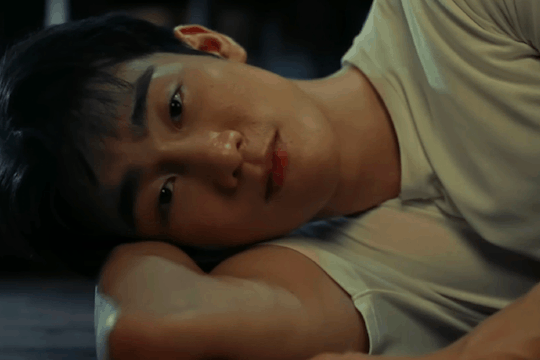
With Phoom locked away, Vicha can't bear the loneliness. Queer suicidality has been haunting Peaceful Properties since the first episode, and the reason Peach keeps his blinds closed in his apartment returned this episode if we didn't recall. But we've had other subtle references, too. Vicha's death, though, was visceral and vivid as he slit his wrists with the same tool he used to count down the days until the return of the person who could affirm his queer feelings. Then, he documented his feeling in poetry with blood. While, Phoom failed to materialize his queerness for others, Vicha could only materialize his queerness through tragedy.
Much of queer history and fiction has focused on these tragic queer figures. In fact, they've been quite productive political tools for advancing queer goals. In the past ten years or so, the culture has turned on tragic queer figures and their narratives, though. Emotionally, I feel like that's for the better, but there's a fine line I'm always attentive to between welcoming empowering histories and turning our backs on those who don't or can't achieve them. It's also a fine line between welcoming ensured happy endings for queer characters and refusing to engage with those creators past and present who use other narrative tools to explore queer themes.
Relatedly, using a branded pairing for Peaceful Property while not advertising it as a BL, nor committing to that status even by episode 7, seems intentionally designed to invite the conversations about whether its queer-baiting or a BL. It feels so old-school to engage in the kind of queer subtext reading that much of the fandom is doing currently. Sure, people do fantastically detailed metas about body language, color theory, and everything else you can think of for BL series. When queerness is not a given, however, the analysis of queer subtext serves the purpose of liberating the characters and the text from the binds and blinds of an otherwise heterosexual context.

There's a generosity in that work. It certainly can't erase the failures to fully live-out one's queerness, nor the problems and behavior that suffering and suppression can lead one to commit. However, sometimes you absolve people out of empathy rather than anything they do to make-up for their harm and futility. Sometimes people are transformed by that initial love, mercy, or understanding, whatever you want to call it, like the ghosts in the series finally being seen. The basic tenets of humanism, a philosophy so disruptive to the rigid class structures the show's simultaneously exploring, and Buddhism, the Thai beliefs which the show's been explicitly exorcising the ghosts with, depend on understanding people at that level, beneath the trappings of social status, symbols of wealth, and even language.
Peaceful Property has taken us on the journey for Home and Peach to understand each other at this level. They, like the audience, have been looking beneath the cloaks of class and patriarchal defensiveness that separate them for the meaningful ephemeral queer gestures that can offer them release from the endless cycles of grief and guilt they're stuck in. That the series keeps finding ways to find peace for these ghosts suggests that the we'll also find peace and love from the alienation haunting Peach and Home. They just need each other to perform that exorcism on their hearts.

*Thailand, specifically, is unique site for queer historians and anthropologists--like director P'Jojo!--because of this question. Its one of the few places that maintained a non-binary gender system into the present, whereas many others were suppressed by Christian colonial law or influence.
#peaceful property#this show is now entering into the range of my fav tv shows of all time#taynew#forcebook#homepeach#peaceful property the series#meta#queer history
315 notes
·
View notes
Text

Figure forms of actresses are stored in a wardrobe room at Twentieth Century Fox studios. Seamstresses use these forms to dress the stars without having to go through fittings. This seamstress is fitting a gown for Betty Grable.
108 notes
·
View notes
Text
Pulp Covers And How To Paint Them
With the rise of cheap printing in the early twentieth century, mass-marked paperbacks swept the world, each offering lurid thrills for obscenely low prices. Sex, sadism, and incredible violence for as little as ten cents. An easy purchase to slot in between fifty cigarettes a day and enough bourbon slugs to kill a small garden.
Pulp fiction is where some of the greats of American literature cut their teeth, including the big three, Raymond Chandler, Ross MacDonald and Dashiell Hammett. The contents of these stories, both the dizzyingly good and astoundingly terrible, have been absorbed and digested and remixed and regurgitated in nearly every permutation imaginable, fuelling pop culture some one hundred years on. This isn't an essay on that. Nobody likes to open a tutorial and be greeted with a wall of text. The history is for another time.
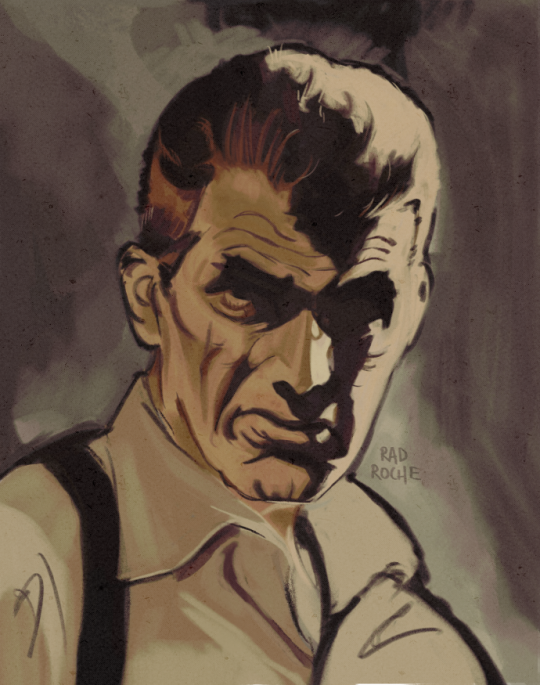
But it is about how to paint it.
Don't let the pre-amble intimidate you, it's not as hard as it sounds. You will need:
Painting software with some image editing capabilities. You don't need all the bells and whistles of Photoshop, but I wouldn't recommend something like MSPaint, at least not to start with. I'm using Clip Studio Paint.
A really beat-up paper texture. The grungier, the better.
A lightly-textured brush. Here are the specific brushes I use, 99% of which is the well-named rough brush. Try and avoid anything with any impasto elements.
Go to your colour-picking tool and use the 'select from layer' option. Doing all the painting on a single layer is going to make your life easier.
A complete willingness to make mistakes and, instead of erasing, painting over them. It generates much more colour variation and interest! Keep your finger off the E key.
Good reference! That painting is a master copy of Mitchel Hooks' art for Day of the Ram. Find a style you really love and want to learn? Have no clue where to begin? Do direct studies!
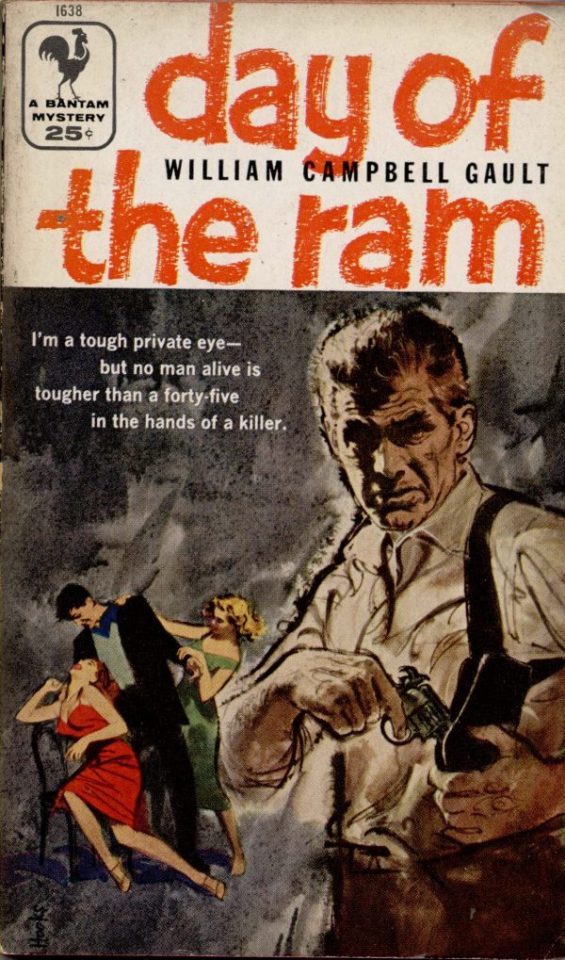
Let's not worry about whatever is happening in the background. It's probably fine. Let's get started! Pulp magazine art is a lot more varied than you might first think, so don't agonize over having a style that 'fits' or not. I'm also specifically aiming for something you'd see on the cover after printing, not the initial painting they would use for printing. The stuff I'll show here is a pretty narrow band of it, but here are some general commonalities. This is a painting by Tom Lovell.
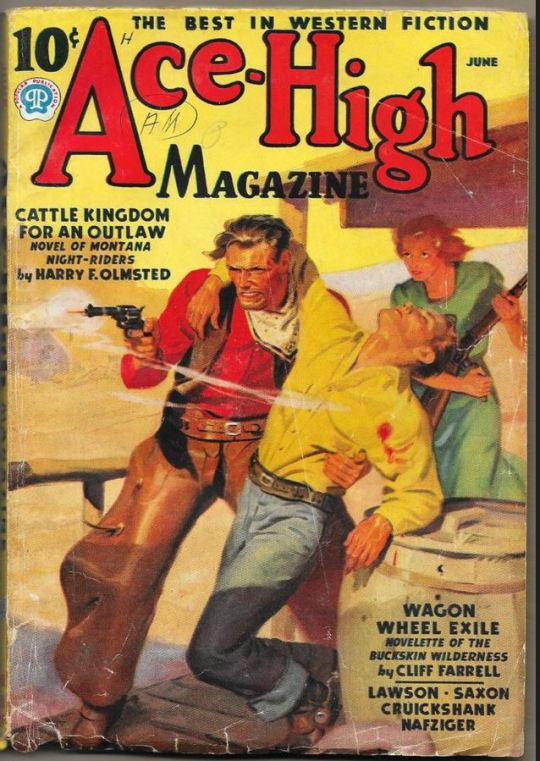
Let's dig into this.

The colours are very bright and saturated, but the actual values, the relative lightness and darkness of them, are actually grouped very simply! You can check this by filling a layer full of black, putting it on top and setting its mode to colour. If the value of a painting looks good, you actually get a lot of leeway with colour. But here's what I think is the most important thing to keep in mind.
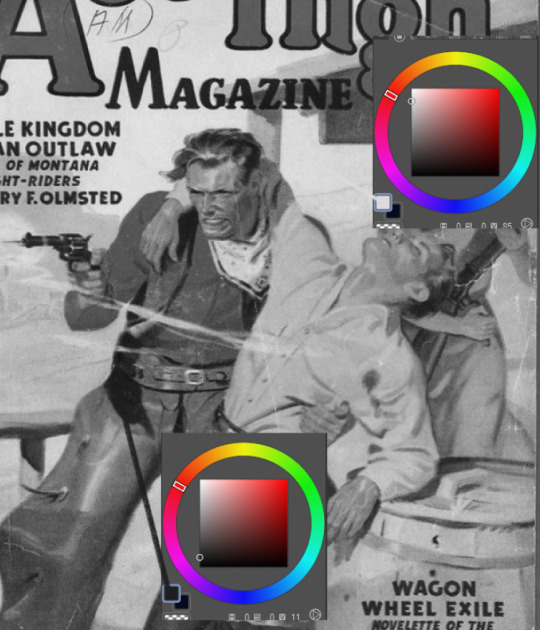
The darks aren't that dark, and the lights aren't all that light! Covers are paintings reproduced on cheap paper. Anything you wouldn't want to happen in the printing process, you lean into. Value wash-outs, lower contrast, colours getting a weird wash to them, really gritty texturing. So let's get painting! Here's my typical setup.
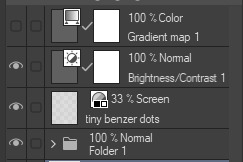
That bottom folder is the painting itself. The screen layer is the grungy paper texture. To get the effect you want, put it down, invert its colour, then set it to screen. That washes out your painting far, far too much, so to compensate, I put a contrast layer up on top. Fiddle around with the settings, but this is where mine ended up sitting.
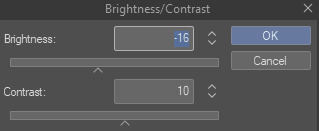
Note I'm saying this before even starting the painting: you want to do this as early as possible. This is where the 'select from layer' colour picker comes in handy. You can paint without worrying about the screen or contrast layer. Something not looking right? Enable your value check layer and keep painting. When you turn it off, it'll still be in colour. Here's a timelapse so you can see what that looks like.
And when you check the values...
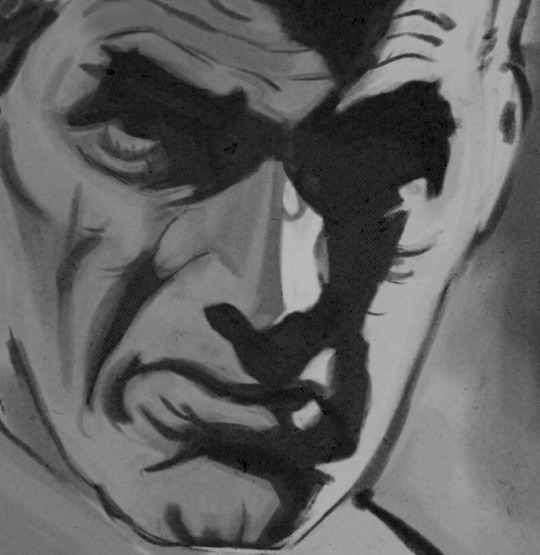
They're pretty simple! This isn't a be all and end all, but I hope it serves as a decent primer. I want thirty dames on my desk by Monday!
#rochedotpng#art tutorial#art resources#couldn't find a thing online about this style so here's how i do it#pulp#it's how i did the death shroud one more or less
354 notes
·
View notes
Text

Marilyn Monroe and Twentieth Century Fox studio head Buddy Adler, 1960
49 notes
·
View notes
Text





There are several versions of the story behind a series of promotional photos taken in 1951 of Marilyn Monroe wearing a potato sack dress.
The best one involves a party at the Beverly Hills Hotel in which Monroe, then 24, allegedly showed up in a revealing red dress that a columnist declared “cheap and vulgar,” adding she would have been better served wearing “a potato sack.” The Twentieth Century Fox PR department then capitalized on the moment by putting her in one.
The less colorful version of the story is that the studio was simply hoping to drum up some publicity by suggesting their starlet was so beautiful, she could even make a potato sack look good — which she indubitably does.
#marilyn monroe#norma jean baker#norma jeane mortenson#40's#50's#vintage#pinup#celebrity#old hollywood#glamour#vintage glamour#pinup girl#american pin up#pinup model
56 notes
·
View notes
Text

“She is beautiful and more than beautiful; she is surprising. Darkness in her abounds, and all that she inspires is nocturnal and profound. Her eyes are two caverns where mystery dimly glistens, and like a lightning flash, her glance illuminates: it is an explosion in the dark.” From the poem The Desire to Paint (1869) by Charles Baudelaire.
"She didn't bother with neurosis; she went straight to psychotic." Music manager and publicist Danny Fields on his friend Nico.
“When she sang with the Velvet Underground it was like a loved one taking a razor to your throat.” Steven Puchalski, Slimetime: A Guide to Sleazy, Mindless Movies (1996) “If they ever held auditions for the Angel of Death, Nico probably would have walked it.” From a 1988 music press obituary for Nico.
Light a black candle! The late, great heroin-ravaged German chanteuse, actress and fashion model Nico (née Christa Päffgen, 16 October 1938 – 18 July 1988) - the Marlene Dietrich of punk, Edith Piaf of The Blank Generation, Warhol Superstar, Moon Goddess, Exiled Countess of Gloom, “possessor of the most haunting wraith cheekbones of the twentieth century” (thank you, James Wolcott of Vanity Fair) - was born on this day 86 years ago. The eternally alluring and inscrutable Nico has always been my favourite singer (and John Waters’ too, for that matter). Portrait of Nico by Maarten Corbijn. (This photo would be adapted for the front cover of Nico’s final studio album Camera Obscura (1985)).
#nico#christa päffgen#moon goddess#warhol superstar#velvet underground and nico#marlene dietrich of punk#lobotomy room#supermodel#chanteuse#diva#wraith cheekbones#gloomy#the marble index#desertshore#the end#camera obscura#maarten corbijn#inscrutable#enigmatic#german chanteuse#german diva#punk diva#punk chanteuse#heroin ravaged chanteuse
38 notes
·
View notes
Text
Paul trying and sometimes failing to be chill about Yoko
“I told John on the phone the other day that at the beginning of last year I was annoyed with him. I was jealous because of Yoko, and afraid about the break-up of a great musical partnership.”
1970, Paul to Ray Connolly in the Evening Standard
I’d been able to accept Yoko in the studio, sitting on a blanket in front of my amp. I’d worked hard to come to terms with that. But then when we broke up and everyone was now flailing around, John turned nasty. I don’t really understand why. Maybe because we grew up in Liverpool, where it was always good to get in the first punch of a fight.
The Lyrics: 1956 to the Present
"It just became impossible for me to work with Yoko sitting there watching us," says Paul. "I wanted to write simple things like 'I love you girl' and every time I knew she was listening I felt I had to come out with someone clever and avant garde! "I'm not blaming Yoko -- I'm blaming me. It was no more John's fault for falling in love with Yoko than it was mine for falling in love with Linda. It just meant that we didn't work together anymore. We tried but it didn't work."
Paul McCartney, in his first magazine interview since the split, tells FLIP's Keith Altham... "THE BEATLES ARE FINISHED!"
We didn’t accept Yoko totally, but like I say, how many groups do you know, these days [who would]? I mean, it’s a joke. It’s like Spinal Tap! I mean, it’s Spinal Tap! A joke!
September, 1986 (MPL Communications, London)
And in John’s thing, you know, when as – you obviously know – he was going through a lot of pain when he said a lot of that stuff. And he felt that we were, um, being kind of vindictive towards him and Yoko. In actual fact I just answered a question on an American TV thing – I think we were quite good, looking back on it, and knowing people in life. Many people would’ve just downed tools with a situation like that and just have said: “Look man, she’s not sitting on our amps while we’re making a film.” I mean, that wouldn’t be unheard of. I mean, Sean Penn... do you know what I mean? Most people would just say, “We’re not having this person here. Don’t care how much you love her.”
But we were actually quite supportive. Not supportive enough, you know; it would have been nice to have been really supportive because then we could look back and say, “Weren’t we really terrific?” But looking back on it, I think we were okay. We were never really that mean to them. But I think a lot of the time John suspected meanness where it wasn’t really there.
September, 1986 (MPL Communications, London)
I’ve already mentioned how in September 1969 we were in a meeting and talking about future plans, and John said, ‘Well, I’m not doing it. I’m leaving. Bye.’ In the ensuing moments, he was giggling and saying how this felt really thrilling, like telling someone you’re going to divorce them and then laughing. At the time, obviously, that was wildly hurtful. Talk about a knockout blow. You’re lying on the canvas, and he’s giggling and telling you how good it feels to have just knocked you out. It took a while, but I suppose I eventually got with the programme. This was my best mate from my youth, the collaborator with whom I’d done some of the best work of the twentieth century (he said, modestly). If he fell in love with this woman, what did that have to do with me? Not only did I have to let him do it, but I had to admire him for doing it. That was the position I eventually reached. There was nothing else I could do but be cool with it.
Paul McCartney, on “Get Back”. In The Lyrics (2021).
MANSFIELD: But, you know, [after John showed me the pictures of himself and Yoko nude for the album cover of Two Virgins], I asked Paul about this. And this, to me, is indicative of their relationship, maybe as much as anything I [had] ever heard. I said, “Paul, you know, what do you think about this?” And Paul says, “I don’t know.” He said, “I don’t really agree with John. But I just am going to figure that John’s ahead of me on this, and that someday I’ll understand and I’ll catch up. So, you know, I’m okay.” ROSEN: And what did that reaction tell you about their relationship? MANSFIELD: That it was an extremely deep relationship.
Ken Mansfield (record label executive and Apple Records U.S. manager), interview w/ James Rosen for Fox News. (December 4th-5th, 2007)
John and Yoko had to visit Sir Joseph Lockwood of EMI with the nude photos to ensure that he would allow their use and there wouldn’t be any censorship problems. Although he personally didn’t like the album or photographs, Paul accompanied the two of them to their meeting. Sir Joseph thought that the fans would be outraged and the Beatles’ reputation would be damaged, but Yoko told him: ‘It’s art.’ Lockwood said: ‘Well, I should find some better bodies to put on the cover than your two. They’re not very attractive. Paul McCartney would look better naked than you.”
The Paul McCartney Encyclopedia by Bill Harry. (also... rekt lmao)
So that – I think, in order to kind of say to Yoko, “Look, my life is now yours,” he had to say things like, “The Beatles were bastards, we were total jerks, we never wrote anything good…” Which I think was rubbish, basically. And as I say, you have to realize that some of that time he was on heroin – so he’s not going to be just talking absolutely lucidly all the time, there. Some of the times, he was having other sorts of problems…
1989, Paul
And I think we would all have continued the Beatles, but Yoko came along, John fell wildly in love with her, he needed a big, big change in his life and he got it! He came to live in New York, he kind of threw over all his English [pause] contacts and everything. And, you know, can’t blame him! If that’s what he wants to do in his life! So we had to kind of, fade into the background to allow them to have their relationship. What were we gonna do, ringin’ him up? ‘Hey John, you know, hey, come and see me! Leave Yoko!’ No, that obviously never gonna happen. [pause] See, you had to let him do what he wanted, and he- he did you know… And he enjoyed it.
Paul McCartney on John’s early 70′s attacks as a sign of his feelings towards him. Interviewed by Bob Costa, 1991.
“. . . I mean, I think really what it was, really all that happened was that John fell in love. With Yoko. And so, with such a powerful alliance like that, it was difficult for him to still be seeing me. It was as if I was another girlfriend, almost. Our relationship was a strong relationship. And if he was to start a new relationship, he had to put this other one away. And I understood that. I mean, I couldn’t stand in the way of someone who’d fallen in love. You can’t say, “Who’s this?” You can’t really do that. If I was a girl, maybe I could go out and… But you know I mean in this case I just sort of said, right – I mean, I didn’t say anything, but I could see that was the way it was going to go, and that Yoko would be very sort of powerful for him. So um, we all had to get out the way.”
Paul McCartney, interview with German tv program Exclusiv, April 1985.
PAUL: ‘Cause she’s very much to do with it from John’s angle, that’s the thing, you know. And I – the thing is that I – there’s— Again, like, there’s always only two answers. One is to fight it, and fight her, and try and get The Beatles back to four people without Yoko, and sort of ask her to sit down at the board meetings. Or else, the other thing is to just realize that she’s there, you know. And he’s not gonna sort of – split with her, just for our sakes.
Twickenham, January 13th, 1969
PAUL: Yeah, see, that’s the thing. The only one time we’ve actually done it, she’s agreed. She really is alright. It’s like, it’s the thought of her being there when some of— [faltering] And then you don’t talk to John, so then he doesn’t talk to you, you know. And it’s like, you can screw it up just as much because she’s there, as – as John’s relying on her because she’s there. So that’s the thing. You know, but I mean, like, you’ll notice, if John – if you’re onto a beam with John about something, then he really isn’t, you know, he really won’t let Yoko talk about it. Because he knows when you’re on a beam, and he knows about it, and you’ll – you can talk straighter to him.
Twickenham, January 13th, 1969
‘All new wives don’t like their husband’s old friends or cronies,’ he replies. ‘I don’t think [Yoko] liked Paul. I think Paul was ready to like Yoko. Maybe she saw Paul as a threat. It was a partnership. The partnership should have been John and Yoko, not John and Paul. I am not saying it was a deliberate process, but it was a natural process. John had a new partner: she. Yoko Ono. It was going to be John and Yoko’s songs and not Paul and John’s songs.’
Don Short (newsman), c/o Sandra Shevey, The Other Side of Lennon.(1990)
As the meeting was drawing to a weary close, John, not this day with Yoko, who hadn’t seemed particularly connected with what was going on, said he wanted to play us a tape he and Yoko had made. He got up and put the cassette into the tape machine and stood beside it as we listened. The soft murmuring voices did not at first signal their purpose. It was a man and a woman but hard to hear, the microphone having been at a distance. I wondered if the lack of clarity was the point. Were we even meant to understand what was going on, was it a kind of artwork where we would not be able to put the voices into a context, and was context important? I felt perhaps this was something John and Yoko were examining. But then, after a few minutes, it became clear. John and Yoko were making love, with endearments, giggles, heavy breathing, both real and satirical, and the occasional more direct sounds of pleasure reaching for climax, all recorded by the faraway microphone. But there was something innocent about it too, as though they were engaged in a sweet serious game. John clicked the off button and turned again to look toward the table, his eyebrows quizzical above his round glasses, seemingly genuinely curious about what reaction his little tape would elicit. However often they’d shared small rooms in Hamburg, whatever they knew of each other’s love and sex lives, this tape seemed to have stopped the other three cold. Perhaps it touched a reserve of residual Northern reticence. After a palpable silence, Paul said, “Well, that’s an interesting one.” The others muttered something and the meeting was over. It occured to me as I was walking down the stairs that what we’d heard could have been an expression of 1960s freedom and openness but was it more likely that it was as if a gauntlet had been thrown down? “You need to understand that this is where she and I are now. I don’t want to hold your hand anymore.”
Michael Lindsay-Hogg (filmmaker), Luck and Circumstance: A Coming of Age in Hollywood, New York, and Points Beyond. (2011)
“Paul, in his usual way, tried to be the nice guy and was open-minded about John’s weird choice,” says Brown. “He invited them to stay at [his house in] Cavendish Avenue for a while.” The day after Cynthia’s return, they moved into the second-floor guest bedroom and made themselves at home. “But the problem was that Yoko wasn’t a very warm person—not even able to say thank you in response to anything Paul did for them. And he went miles out of his way to make them feel welcome, being a nice guy. So that didn’t last very long.”
The Beatles – Bob Spitz
PMcC: I always had the impression that Klein had got them to go with him because he was the only one who was ever sympathetic to Yoko. Klein saw the Yoko connection and told Yoko that he would do a lot for her. Give Yoko a lot. And that was basically what John and Yoko wanted, recognition for Yoko. We found her sitting on our amps, and like a football team, an all-male thing, you really don’t like to see a chick in the middle of the team. It’s a disturbing thing, they think it throws them off the game or whatever it was, and these were the reasons that I thought, Well, this is crazy, we’re gonna have Yoko in the group next.
SG: She was giving you advice in the studio?
PMcC: Well, she was definitely turning up. Looking at it now, I feel a bit sorry for her because, if only I had been able to understand what the situation was and think, wait a minute, here’s a girl who’s not had enough attention. I can now not make this into a major crisis and just sort of say, “Sure, what harm is she doing on the amps?” I know they would have really loved me. You know, we didn’t like Yoko at first, and people did call her ugly and stuff, and that must be hard for someone who loves someone and is so passionately in love with them, but I still can’t—I’m still trying to see his point of view. What was the point of all that?
All You Need is Love: The Beatles in Their Own Words by Peter Brown and Steven Gaines (thank you @tavolgisvist!)
Examples of failure to be chill:

PAUL: But it’s just funny to sort of realise that after this is all over, you’ll be off in a black bag somewhere – on the Albert Hall, you know. JOHN: Yes. PAUL: And sort of doing shows and stuff, and you know, digging— JOHN: Yeah, but I— PAUL: —digging that thing of it.
January 25th, 1969 (Apple Studios, London)
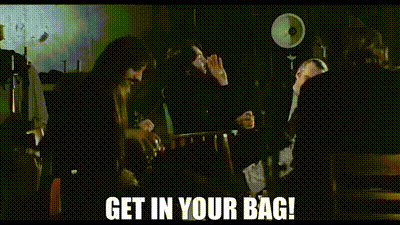
Yoko had evidently approached Paul McCartney about appearing in the film, as the Beatles' road manager Mal Evans penned in his diary: "PAUL HAS APPOINTMENT WITH JAPANESE LADY WHO WANTS TO PHOTOGRAPH HIS BOTTOM." Presumably Paul declined, and one must wonder if the same invitation might have been extended to John.
Chip Madinger, Lennonology Volume 1: Strange Days Indeed. (2015) (note: unforgivable rudeness on Paul's part to both Yoko and all of us who would have benefited from him featuring in "Bottoms")
“I was in India meditating about the album, when it suddenly hit me. I wrote Yoko telling her that I planned to have her in the nude on the cover. She was quite surprised, but nowhere near as much as George and Paul. “Paul gave me long lectures about it, and said ‘Is there really any need for this? ‘It took me five months to persuade them.
NEW MUSICAL EXPRESS, JUNE 7, 1969
He wasn’t happy. But the big things that were driving him mad were beyond me. He kept on working and writing, but when John came over, all he could talk about was how much he loved Yoko. That disturbed Paul. In spite of John’s obvious happiness, Paul stifled his jealousy with not-very-cute bursts of racist crap.
Francie Schwartz - Body Count
John & Yoko's perspective:
It’s the same. You can quote Paul, it’s probably in the papers, he said it many times at first he hated Yoko and then he got to like her. But, it’s too late for me. I’m for Yoko. Why should she take that kind of shit from those people? They were writing about her looking miserable in the Let It Be film, but you sit through 60 sessions with the most bigheaded, up-tight people on earth and see what its fuckin’ like and be insulted — just because you love someone — and George, shit, insulted her right to her face in the Apple office at the beginning, just being ‘straight-forward,’ you know that game of ‘I’m going to be up front,’ because this is what we’ve heard and Dylan and a few people said she’d got a lousy name in New York, and you give off bad vibes. That’s what George said to her! And we both sat through it. I didn’t hit him, I don’t know why.
I was always hoping that they would come around. I couldn’t believe it, and they all sat there with their wives, like a fucking jury and judged us and the only thing I did was write that piece (Rolling Stone, April 16th, 1970) about “some of our beast friends” in my usual way — because I was never honest enough, I always had to write in that gobbly-gook — and that’s what they did to us.
Ringo was all right, so was Maureen, but the other two really gave it to us. I’ll never forgive them, I don’t care what fuckin’ shit about Hare Krishna and God and Paul with his “Well, I’ve changed me mind.” I can’t forgive ’em for that, really. Although I can’t help still loving them either.
John Lennon: The Rolling Stone Interview, Part One
JOHN: But I understand how they felt, because if it had been Paul or George and Ringo that had fallen in love with somebody and gotten totally involved, suddenly… It wasn’t like, you know, somebody – George coming in and saying, “I’m going to work with Eric Clapton in a band now, and screw you.” It wasn’t that kind of thing at all. It was just suddenly this involvement.
December 6th, 1980: Andy Peebles talks to John and Yoko
“Lennon stated that “there’s some underlying thing about Yoko in [Get Back]”, saying that McCartney looked at Yoko Ono in the studio every time he sang “Get back to where you once belonged””
David Sheff, All We are Saying: The Last Major Interview with John Lennon and Yoko Ono
TRYNKA: ‘The Ballad of John And Yoko’, with Paul playing drums and bass, seemed like Paul’s tribute to you. Was that the case? YOKO: Yeah. I thought that was beautiful. Paul was trying to be diplomatic about the situation, try to make it well... He meant well. There were other instances where he’d do things that were meant well.
Yoko Ono, interview w/ Paul Trynka for MOJO. (May, 2003)
YOKO: Even now, I just read that Paul said, “I understand that he wants to be with her, but why does he have to be with her all the time?” JOHN: Yoko, do you still have to carry that cross? That was years ago. YOKO: No, no, no. He said it recently. I mean, what happened with John is that I sort of went to bed with this guy that I liked and suddenly the next morning I see these three guys standing there with resentful eyes. SHEFF: Do you think that kind of attitude from people was also jealousy? JOHN: It’s a kind of jealousy. People can’t stand people being in love. They absolutely can’t stand it. They want to pull you down in the hole they’re in.
John Lennon and Yoko Ono, interview w/ David Sheff for Playboy. (September, 1980)
‘He wanted me to be part of the group,’ Yoko says. ‘He created the group, so he thought the others should accept that. I didn’t particularly want to be part of them… I couldn’t see how I would fit in, but John was certain I would. He kept saying, ‘They’re very sensitive … Paul is into Stockhausen… They can do your thing…’ He thought the other Beatles would go for it; he was trying to persuade me.’”
Philip Norman’s 2008 biography Lennon
After the initial embarrassment, that how Paul is being very nice to me, he’s nice and a very, str- on the level, straight, sense, like wherever there’s something like happening at the Apple, he explains to me, as if I should know. And also whenever there’s something like they need a light man, or something like that he asks me if I know of anybody, things like that. And like I can see that he’s just now suddenly changing his attitude, like his being, he’s treating me with respect, not because it’s me, but because I belong to John. I hope that’s what it is because that would be nice. And I feel like he’s my younger brother or something like that. I’m sure that if he had been a woman or something, he would have been a great threat, because there’s something definitely very strong with me, John, and Paul.
Revolution Chaos Tape – Yoko Ono, June 4, 1968
"The line [the walrus was Paul] was put in partly because I was feeling guilty because I was with Yoko and I was leaving Paul. It's a very perverse way of saying to Paul: 'here, have this crumb, this illusion, this stroke - because I'm leaving.'" -John
Playboy, 1980
JOHN: And throwing in the line “the Walrus was Paul” just to confuse everybody a bit more. And because I felt slightly guilty because I’d got Yoko, and he’d got nothing, and I was gonna quit. [laughs; bleak] And so I thought ‘Walrus’ has now become [in] meaning, “I am the one.” It didn’t mean that in the song, originally. It just meant I’m the – it could have been I’m the – “I’m The Fox Terrier,” you know. I mean, it’s just a bit of poetry.
August, 1980: John talks to Playboy writer David Sheff about ‘Glass Onion’.
“Still, the real reason that people disliked Yoko was because she ordered them about and sent them on errands in a particularly rude way; she was brought up with servants, and that’s how she treated the staff of Apple. George found it particularly galling that she never gave the Beatles their definite article. He told me, ‘She would say, “Beatles do this” and “Beatles do that”, and we would say, “Uh, it’s the Beatles actually, love.” She’d look at you and say, “Beatles do this.”’ And he laughed and shrugged his shoulders. Whether Yoko was ever aware of the disruption her presence caused to the Beatles’ working practices I don’t know. Some people thought she was so involved in her own work and self-interest that she didn’t notice; others thought that it was a deliberate ploy to separate John off from the others.”
Barry Miles, The Zapple Diaries. (2015)
#the beatles#paul mccartney#john lennon#mclennon#he could only play nice for so long#the bag thing pissed him off too much
122 notes
·
View notes
Text









January 17th 1883 saw the birth of Compton Mackenzie, in Hartlepool in North East England.
Compton Mackenzie is today best remembered for writing two comic novels set in Scotland – The Monarch of the Glen, which inspired the BBC drama series of the same name, and the much-loved Whisky Galore, which has twice been adapted for cinema. The story of a fictional Hebridean island taking advantage of a ship wreck full of spirits at the height of wartime rationing has entertained generations since it first appeared in 1947. The most recent cinematic version, starring Gregor Fisher, goes on general release in May. But Mackenzie was much more than a gentle chronicler of the Highlands and islands in the mid-20th century.
He was, at various times, an actor, soldier, Government spy, political activist, journalist, Jacobite supporter, cultural commentator, snooker enthusiast, raconteur and, in 1928, a co-founder of the National Party of Scotland – the forerunner to the modern SNP.
Andro Linklater, who wrote a biography of Mackenzie, commented: “(He) wasn’t born a Scot, and he didn’t sound like a Scot. But nevertheless his imagination was truly Scottish.” Edward Montague Compton Mackenzie was born in West Hartlepool in 1883 and raised in London. His was a theatrical family – many of whose members used Compton as their stage name. His grandfather Henry Compton was a well-known Shakespearean actor of the Victorian era. A history graduate of Magdalen College, Oxford, the young Mackenzie published his first novel in 1912 but his writing career was stalled by the outbreak of war. He quickly signed up and saw action at Gallipoli. In 1915 he was recruited into the fledgling Secret Service and was posted across the eastern Mediterranean. Although he would later be awarded a knighthood, Mackenzie was no darling of the British establishment. In 1932 he was hauled before the courts and fined for breaching the Official Secrets Act for writing Greek Memories – a candid reflection of his time as a spy. At a time when the British public was scarcely aware of the security services, Mackenzie freely outlined its organisation. It was withdrawn from sale and was only published in full as recently as 2011.
In 1933 he took revenge on the Secret Service with Water on the Brain, an obvious swipe at the Service. Despite its satirical cover, he managed to include a few genuine morsels – such as the fact that the chief of the Service always wrote in green ink. At story’s end, the location of the Secret Service’s headquarters is revealed in a spy thriller and the spooks have to move out. The building becomes an asylum for “the servants of bureaucracy who have been driven mad in the service of the country”. By this point Mackenzie was already resident in Scotland and had become close friends with the poet Hugh MacDiarmid and the influential writer, thinker and adventurer Robert Cunninghame Graham. Together they helped establish the National Party of Scotland in 1928, which emerged in 1934 as the modern SNP.
Mackenzie settled on the Hebridean island of Barra and concentrated on his most ambitious project, The Four Winds of Love. Gavin Wallace, another of his biographers, later wrote: “The Four Winds of Love, published in six volumes between 1937 and 1945 and containing almost 1 million words, is one of the most ambitious Scottish novels of the twentieth century, an enormous historical odyssey which anatomizes the politics of peripheral nationalism both throughout Europe and in Britain, again through semi-autobiographical character development.” But it was Mackenzie’s comic novels that won him UK-wide fame and fortune. Whisky Galore, based on a real-life incident in Eriskay in 1941, was first adapted for the big screen by Ealing studios and released to popular acclaim in 1948. The enduring appeal of the novel was later summed up by one Scotsman literary critic: “So what if it perpetrates the old, cliched ‘Brigadoon’ myth? Scots, English, American or Martian, no-one can resist this tale of ill-gotten whisky gain on a Scottish island in wartime. It’s simply hilarious.” Such was Mackenzie’s status as an elder statesman of letters he was knighted in 1952 and remained a much-respected cultural commentator for the rest of his life. In later years he lived in Drummond Place, in Edinburgh’s New Town, where he died from cancer aged 89, in 1972. Lavish tributes followed. Dr Robert McIntyre, president of the SNP and the first Scottish nationalist elected to parliament, described Mackenzie as “the Grand Old Man of Scotland”. Novelist Eric Linklater said he was a “consummate stylist, who, unlike most writers, also lived with style.”
19 notes
·
View notes